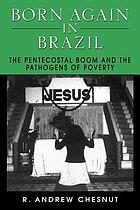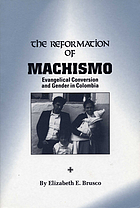
While recurring struggles against and within the Catholic Church continued in the newly independent nations, Protestant missionaries began to arrive in Latin America. Because so many were from the United States or Great Britain, they were seen as purveyors of modernity and, although conservative Catholics remained suspicious of their proselytizing, many believed the missionaries would help to forge tighter connections between Latin America and the industrializing world. Mainline Protestant denominations such as Presbyterians, Anglicans, Methodists, and Baptists made some inroads, especially among the elites. It was, however, the arrival of Pentecostal missionaries in the twentieth century, with their focus on the baptism of the Holy Spirit, that marked the beginning of the embrace of Protestantism by the masses. Over the course of the twentieth century, Pentecostalism grew exponentially throughout the region. Even more than Roman Catholics, Protestants insisted on an all or nothing commitment to the Christian faith. Thus, scholars have become interested in why, especially in the hybrid cultures of Latin American nations, Protestantism eventually took root and then grew dramatically in the late twentieth century.
R. Andrew Chesnut’s Born Again in Brazil: The Pentecostal Boom and the Pathogens of Poverty focuses on a community in the northern region of Brazil to argue that the faith-healing component of Pentecostalism had great appeal to those who were unable to afford doctors. Elizabeth Brusco examines evangelicalism in Colombia in The Reformation of Machismo: Evangelical Protestantism and Gender in Colombia. She finds that the evangelical Protestant focus on collaboration between husbands and wives, on attending church together, and on sharing household responsibilities contributed to a more stable family life. Forbidding the use of alcohol and tobacco products also freed up financial resources previously squandered by husbands to be used for the good of the entire family. A less tumultuous home life often meant men performed better at their jobs, further contributing to financial stability. Thus, evangelical Protestantism provided tangible material gains for Colombian families.
Another major transformation in religion in twentieth-century Latin America was the emergence of the theology of liberation during the 1960s and 1970s. In the early 1960s, Pope Paul VI presided over the Second Vatican Council, exploring ways to make the Church more meaningful in the modern world. At the same time, following the 1959 revolution in Cuba, conservative Latin American elites became increasingly concerned that movements demanding a fairer distribution of national resources might be co-opted by Soviet-leaning Marxists. As a result, they supported right-wing military dictatorships bent on protecting the right to property and upholding the privileges of the few. A number of Catholic intellectuals and clergy protested, pointing out that Christ’s redemptive work included liberation from the consequences of sin, which included poverty and inequality. Activist catechists and clergy began to organize their parishioners to study the Bible as a path to political and economic liberation. In 1968, complying with a papal directive, the Conference of Latin American Bishops met in Medellin, Colombia, to discuss specific ways of applying Vatican II reforms in their region. Their conclusions are outlined in Gustavo Gutierrez’s A Theology of Liberation: History, Politics, and Salvation. Among other things, they argued that Christians must embrace a “preferential option for the poor,” for although God loves all equally, society’s weakest must also be the most protected. Exploiting the poor, they proclaimed, was sinful; economic and political systems that perpetuated poverty comprised “structural sin” and must be shattered, by violent revolution, if necessary. Phillip Berryman’s Liberation Theology: Essential Facts about the Revolutionary Religious Movement in Latin America--and Beyond provides a clear description of the position of progressive churchmen and their allies. These “Marxist” Christians troubled their right-wing governments; they also raised concerns in the Vatican. Many young people who had perceived the Church as old-fashioned and out of touch, however, rallied to the call to bring God’s kingdom to earth as they joined the struggle to ensure equality for the poor and oppressed. All over the region, proponents of the theology of liberation joined with students and labor activists to resist oppressive military regimes. Once again, the Church became politically active and divided. In the polarized atmosphere of the Cold War, conservative Catholics believed proponents of liberation theology had lost their faith by embracing godless Marxism, dangerously subverting law and order and thereby opening the way for communists to wrest political power.
When Central America became a proxy region for Cold War battles, churchmen paid with their lives for siding with the poor. The best known casualty was the archbishop of San Salvador in El Salvador, Óscar Romero. The story of his transformation from a conservative bishop to the archbishop who was the “voice of the voiceless” and defender of the poor against the powerful military is told by James R. Brockman in Romero: A Life. Shot to death while saying mass, Romero made the ultimate sacrifice for his people. A useful synthesis of the long conflict in Central America is found in Phillip Berryman’s The Religious Roots of Rebellion: Christians in Central American Revolutions. As civil wars ravaged the region, destroying traditional villages, many found a measure of safety in the community offered by Protestant churches. Virginia Garrard-Burnett provides a carefully researched account of this transformation in Protestantism in Guatemala: Living in the New Jerusalem. One of the unforeseen consequences was the eventual rise to power in Guatemala of a general who was also a Pentecostal Christian. The combination of extreme anti-communism with Pentecostal values of morality, stability, and security brought dire consequences, especially for the Maya population, as discussed in Garrard-Burnett’s Terror in the Land of the Holy Spirit: Guatemala under General Efraín Ríos Montt, 1982–1983.
In Brazil, the military deposed a civilian president in 1964 in order to protect the nation from communism. During the ensuing twenty-one years of military rule, many within the Church hierarchy steadfastly opposed the regime in power and provided refuge for dissidents. Thomas C. Bruneau focuses on this period in The Church in Brazil: The Politics of Religion. Kenneth Serbin’s Secret Dialogues: Church-State Relations, Torture, and Social Justice in Authoritarian Brazil uncovers the clandestine meetings of men on opposite sides of the ideological divide who nevertheless shared similar socioeconomic backgrounds and sought to find a way forward for their deeply divided nation. Serbin’s later work, Needs of the Heart: A Social and Cultural History of Brazil’s Clergy and Seminaries, documents the education of churchmen before and during the military regime, addressing the social backgrounds and aspirations of Brazilians whose chosen vocation was the priesthood.
The years of military rule witnessed further expansion of Pentecostal Protestantism. John Burdick, in Looking for God in Brazil: The Progressive Catholic Church in Urban Brazil’s Religious Arena, examines the ultimate failure of liberation theology to capture the hearts of ordinary Brazilians. He argues that progressive Catholics, intent on political transformation, failed to grasp the importance of mystical spirituality for many ordinary Brazilians who left the Catholic Church to join Pentecostal sects. The military years also saw the growth of Brazil’s movimento negro, a black empowerment movement. In Blessed Anastacia: Women, Race and Popular Christianity in Brazil, Burdick finds that popular Catholicism, Pentecostal sects, and devotion to the mythical slave Anastacia became more relevant to Afro-Brazilian women than the black power movement, because they each, in their own way, imbued dark-skinned women with pride in their heritage and confidence in their beauty.
While many of the Brazilian clergy resisted the military regime, a number of Argentine priests remained silent or actually colluded with their military presidents in the effort to eradicate the perceived communist threat. During the most oppressive years of dictatorship (dubbed the “Dirty War”), thousands of Argentine men and women disappeared into clandestine jails where they were tortured and killed (los desaparecidos). In this most European of Latin American nations, with its strong traditional Roman Catholic culture, the barbarity of the regime that presented itself as a bastion of Christianity shocked the world. Both Emilio F. Mignone’s Witness to the Truth: The Complicity of Church and Dictatorship in Argentina and Gustavo Morello’s The Catholic Church and Argentina’s Dirty War are valuable resources for understanding this dark period of Argentine history.
 Born again in Brazil : the Pentecostal boom and the pathogens of poverty
by
Born again in Brazil : the Pentecostal boom and the pathogens of poverty
by
 The reformation of machismo : evangelical conversion and gender in Colombia
by
The reformation of machismo : evangelical conversion and gender in Colombia
by
 Terror in the land of the Holy Spirit : Guatemala under General Efraín Ríos Montt, 1982-1983
by
Terror in the land of the Holy Spirit : Guatemala under General Efraín Ríos Montt, 1982-1983
by
 Blessed Anastácia : women, race, and popular Christianity in Brazil
by
Blessed Anastácia : women, race, and popular Christianity in Brazil
by